

高等学校化学学报 ›› 2021, Vol. 42 ›› Issue (8): 2332.doi: 10.7503/cjcu20210232
收稿日期:2021-04-07
出版日期:2021-08-10
发布日期:2021-08-05
通讯作者:
潘锋
E-mail:panfeng@pkusz.edu.cn
基金资助:Received:2021-04-07
Online:2021-08-10
Published:2021-08-05
Contact:
PAN Feng
E-mail:panfeng@pkusz.edu.cn
Supported by:摘要:
开发新型高能量密度以及低成本的锂离子电池, 是有效应对能源危机和环境挑战的可行路径之一. 锂离子电池材料的电子结构与电子态的演化决定了材料诸多本征性质以及电池综合性能. 探测并操控电极材料电子态的演化对探求电极反应的物理机理、 促进电池材料发展具有重要意义. 基于同步辐射的软X射线光谱技术可以直接探测费米能级附近的电子态. 本文从阴阳离子氧化还原反应的不同角度对利用软X射线光谱对电子态演变的研究进行了总结, 获得了电极材料电化学循环过程中过渡金属与氧的电子态演化信息, 系统阐述并总结了不同锂离子电池材料中电子态的演化以及氧化还原反应机理的最新研究进展.
中图分类号:
TrendMD:
卓增庆, 潘锋. 基于软X射线光谱的锂电池材料的电子结构与演变的研究进展. 高等学校化学学报, 2021, 42(8): 2332.
ZHUO Zengqing, PAN Feng. Progress of Key Electronic States in Lithium Ion Battery Materials Probed Through Soft X-ray Spectroscopy. Chem. J. Chinese Universities, 2021, 42(8): 2332.
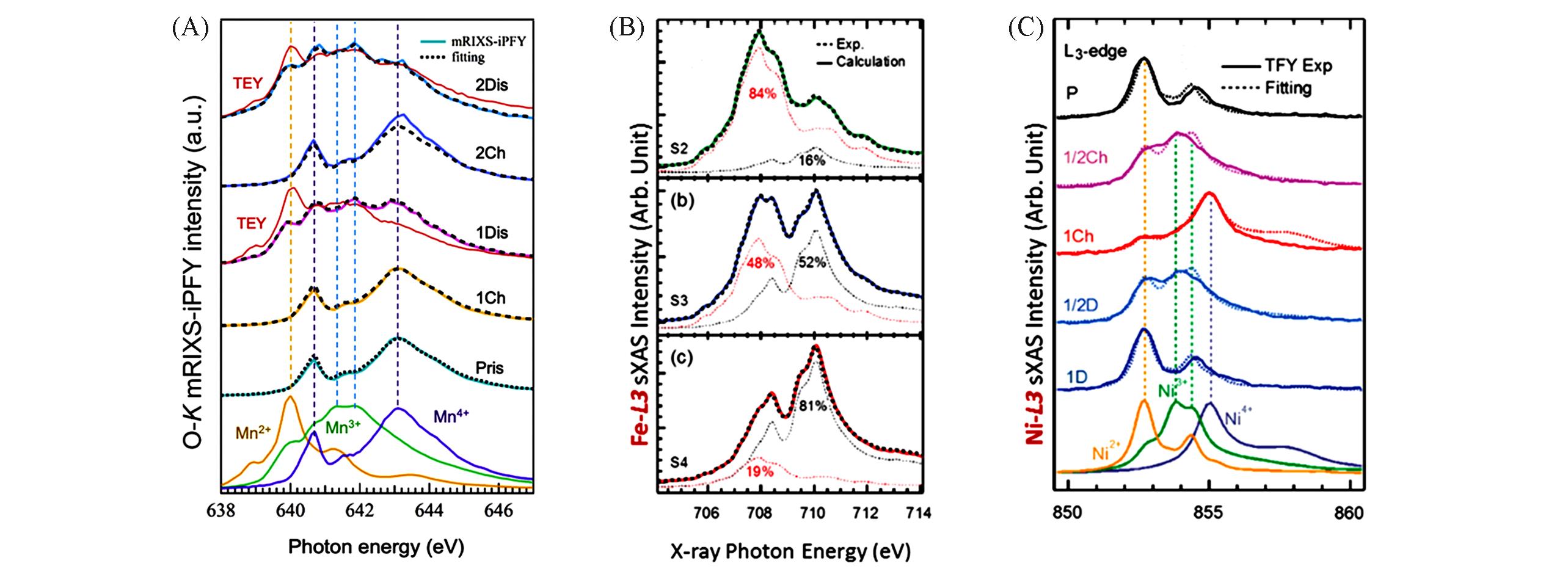
Fig.1 Quantitative definition of TM oxidation states of Mn in Li2MnO3(A)[37], Fe in LiFePO4(B)[29], and Ni in LiNi0.5Mn1.5O4(C)[32] battery electrodes at different electrochemical stages(A) Copyright 2021, Elsevier; (B) Copyright 2012, American Chemical Society; (C) Copyright 2015, American Chemical Society.
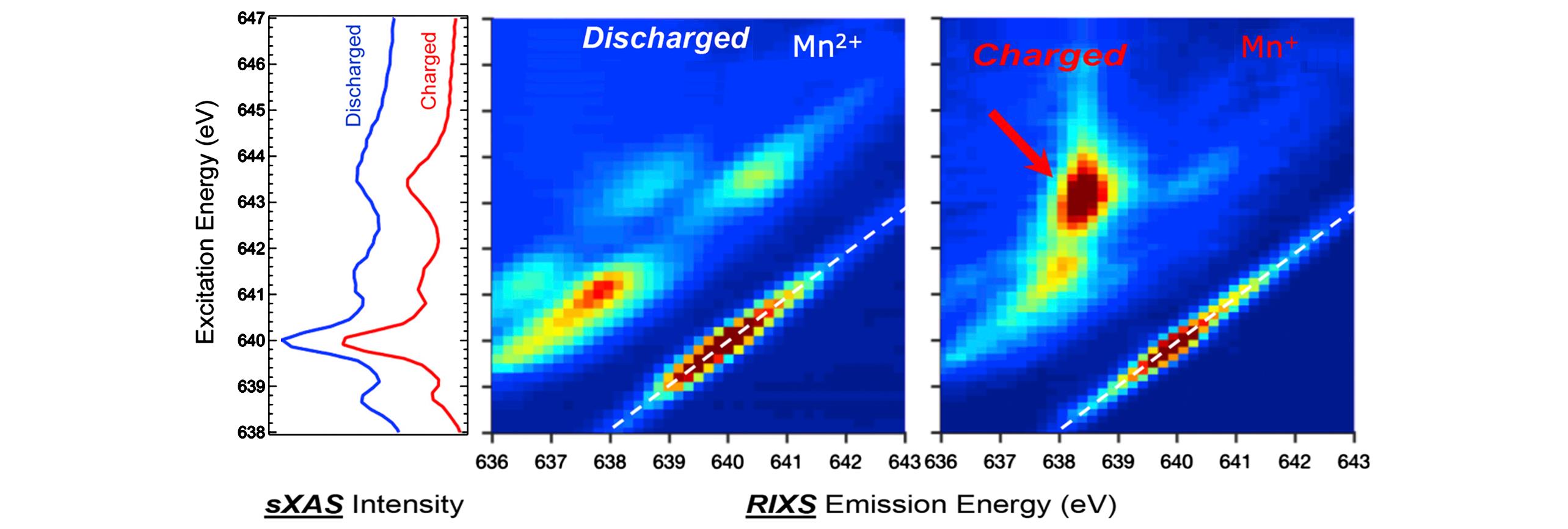
Fig.2 Spectra contrast between a discharged and charged anode based on a Prussian Blue Analogue material of Na1.24Mn[Mn(CN)6][28]Copyright 2018, Springer Nature.
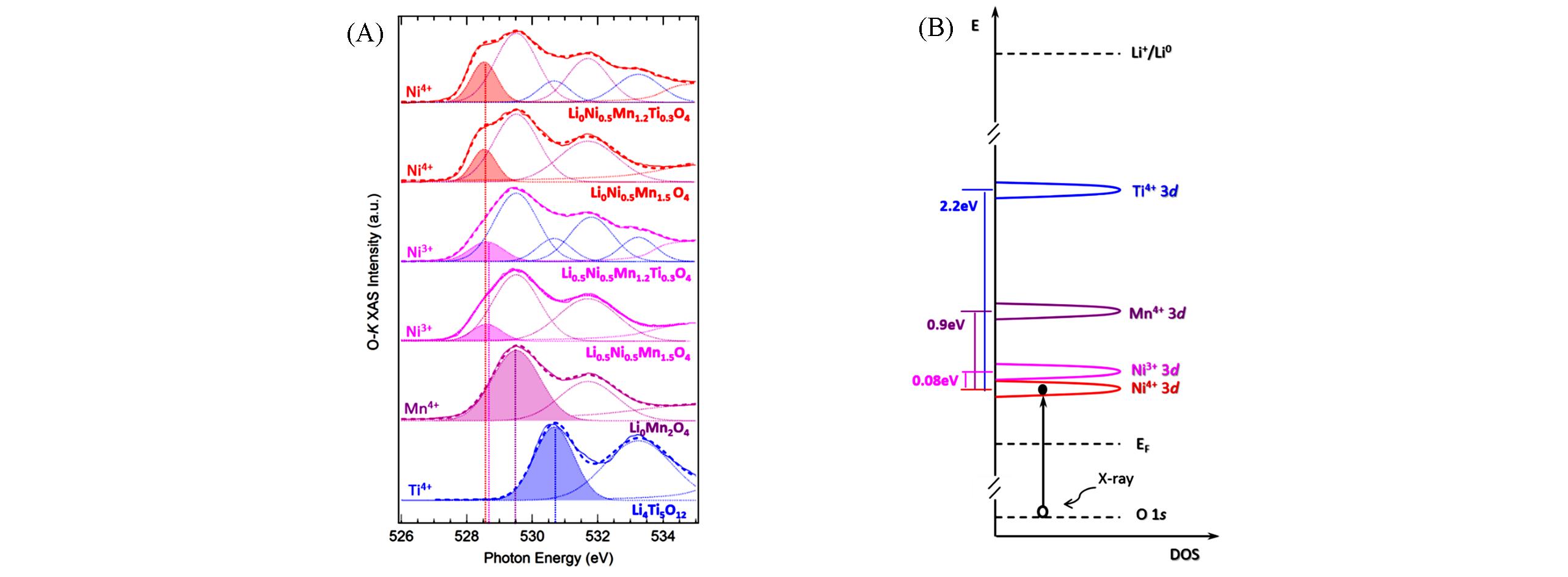
Fig.4 O?K sXAS pre?edge features of electrochemically cycled spinel materials at different states(A) and schematic of simplified atomic model of sXAS(B)[17](A) Solid and dashed lines represent experimental plots and fitted curves, respectively. The Gaussian peaks under each spectrum represents the fitting peaks corresponding to specific TM states that are color coded. Copyright 2021, Wiley?VCH.
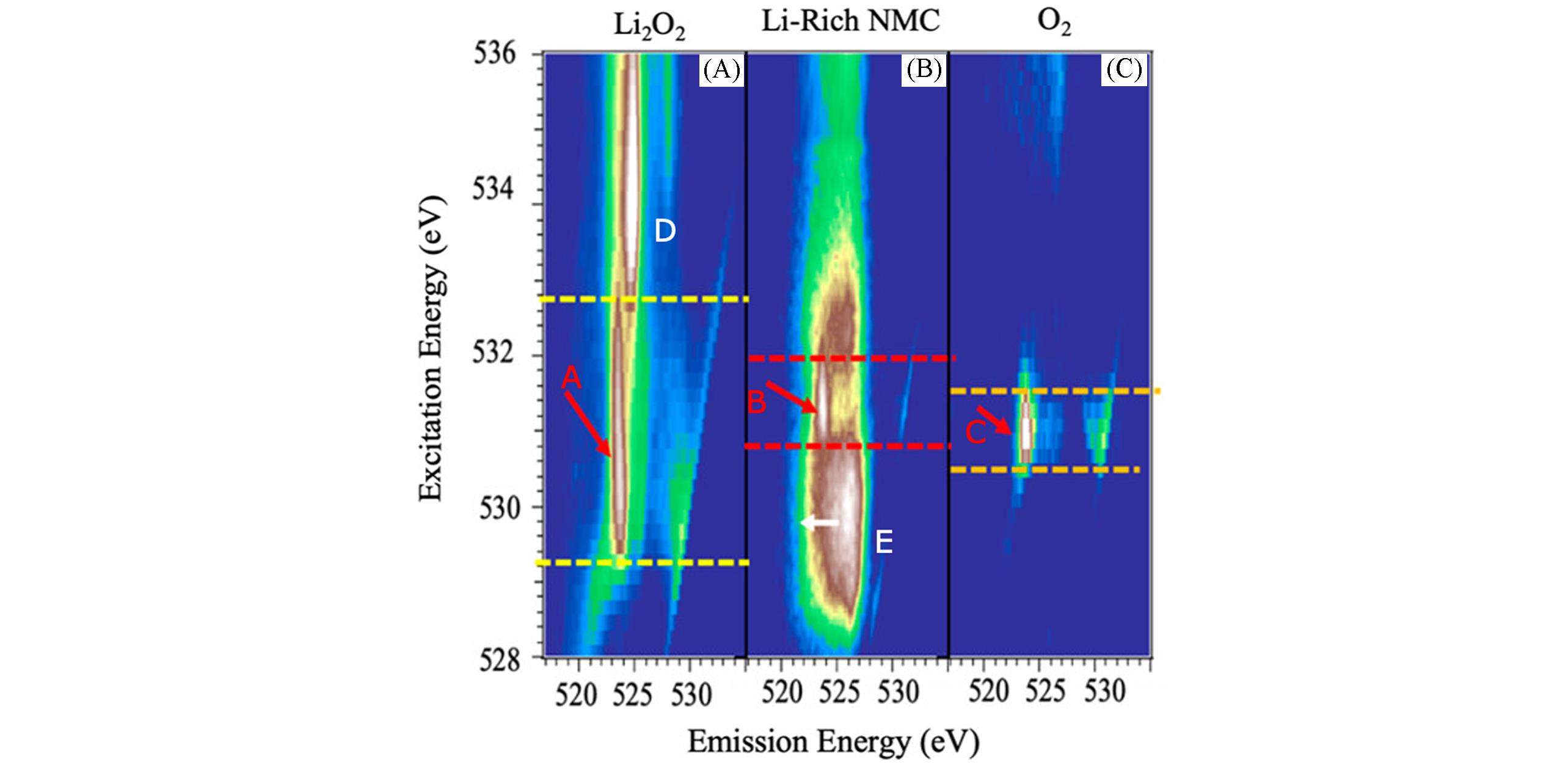
Fig.5 Direct comparison of full mRIXS profile of oxidized oxygen states in three systems of Li2O2(A)[18], charged Li?rich Li1.17Ni0.21Co0.08Mn0.54O2(B)[40] and O2(C)[16](A) Copyright 2018, American Chemical Society; (B) Copyright 2017, Springer Nature; (C) Copyright 2020, American Chemical Society.
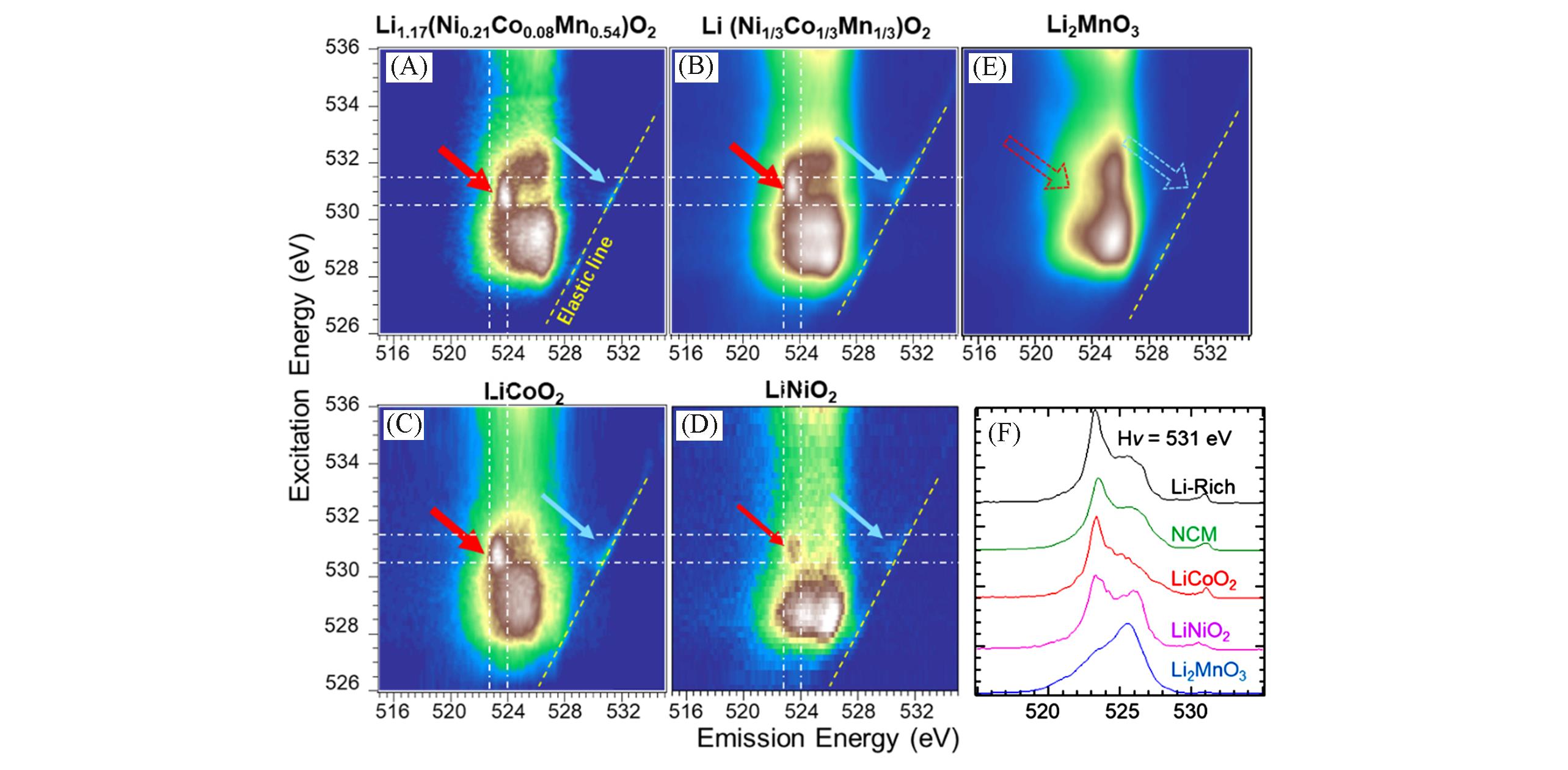
Fig.6 Direct comparison of full mRIXS profile of oxidized oxygen states in different systems of Li1.17Ni0.21Co0.08Mn0.54O2(A)[40], NMC111(B)[42], Li2MnO3(C)[37], LiCoO2(D)[37] and LiNiO2(E)[30], lineshape comparison of the RIXS cuts at 531 eV excitation energy of all the electrodes(F)(A) Copyright 2017, Springer Nature; (B) Copyright 2020, Wiley?VCH; (C, E) Copyright 2021, Elsevier;(D) Copyright 2019, American Chemical Society.
| 39 | Oishi M., Fujimoto T., Takanashi Y., Orikasa Y., Kawamura A., Ina T., Yamashige H., Takamatsu D., Sato K., Murayama H., Tanida H., Arai H., Ishii H., Yogi C., Watanabe I., Ohta T., Mineshige A., Uchimoto Y., Ogumi Z., J. Power Sources,2013, 222, 45—51 |
| 40 | Gent W. E., Lim K., Liang Y., Li Q., Barnes T., Ahn S. J., Stone K. H., McIntire M., Hong J., Song J. H., Li Y., Mehta A., Ermon S., Tyliszczak T., Kilcoyne D., Vine D., Park J. H., Doo S. K., Toney M. F., Yang W., Prendergast D., Chueh W. C., Nat. Comm.,2017, 8(1), 2091 |
| 41 | Li Q., Lebens⁃Higgins Z. W., Li Y., Meng Y. S., Chuang Y. D., Piper L. F. J., Liu Z., Yang W., J. Phys. Chem. Lett.,2021, 12(4), 1138—1143 |
| 42 | Lee G. H., Wu J., Kim D., Cho K., Cho M., Yang W., Kang Y. M., Angew. Chem. Int. Ed.,2020, 132(22), 8759—8766 |
| 43 | House R. A., Rees G. J., Pérez⁃Osorio M. A., Marie J. J., Boivin E., Robertson A. W., Nag A., Garcia⁃Fernandez M., Zhou K. J., Bruce P. G., Nat. Energy,2020, 5, 777—785 |
| 44 | House R. A., Maitra U., Pérez⁃Osorio M. A., Lozano J. G., Jin L., Somerville J. W., Duda L. C., Nag A., Walters A., Zhou K., Roberts M. R., Bruce P. G., Nature,2020, 577(577), 502—508 |
| 1 | Yang W., Liu X., Qiao R., Olalde⁃Velasco P., Spear J. D., Roseguo L., Pepper J. X., Chuang Y. D., Denlinger J. D., Hussain Z., J. Electron Spectros. Relat. Phenomena,2013, 190, Part A, 64—74 |
| 2 | Ament L. J. P., van Veenendaal M., Devereaux T. P., Hill J. P., van den Brink J., Rev. Mod. Phys.,2011, 83(2), 705—767 |
| 3 | Groot F. D., Kotani A., Core Level Spectroscopy of Solids, CRC Press Taylor & Francis Group, Boca Raton London New York, 2008 |
| 4 | Stöhr J., NEXAFS Spectroscopy, Springer, New York, 1996 |
| 5 | Goodenough J. B., Kim Y., Chem. Mater.,2010, 22(3), 587—603 |
| 6 | Liu C., Neale Z. G., Cao G., Mater. Today,2016, 19(2), 109—123 |
| 7 | Grimaud A., Hong W. T., Shao⁃Horn Y., Tarascon J. M., Nat. Mater.,2016, 15(2), 121—126 |
| 8 | Armand M., Tarascon J. M., Nature,2008, 451(7179), 652—657 |
| 9 | Li M., Liu T., Bi X., Chen Z., Amine K., Zhong C., Lu J., Chem. Soc. Rev.,2020, 49(6), 1688—1705 |
| 10 | Yang W., Devereaux T. P., J. Power Sources,2018, 389,188—197 |
| 11 | Zhuo Z., Pan F., Yang W., Chinese J. Struc. Chem.,2019, 38(12), 2009—2014 |
| 12 | Lin F., Liu Y., Yu X., Cheng L., Singer A., Shpyrko O. G., Xin H. L., Tamura N., Tian C., Weng T. C., Yang X. Q., Meng Y. S., Nordlund D., Yang W., Doeff M. M., Chem. Rev.,2017, 117(21), 13123—13186 |
| 13 | Frati F., Hunault M. O. J. Y., de Groot F. M. F., Chem. Rev.,2020, 120(9), 4056—4110 |
| 14 | Olalde⁃Velasco P., Jiménez⁃Mier J., Denlinger J. D., Hussain Z., Yang W. L., Phys. Rev. B,2011, 83(24), 241102 |
| 15 | Yang W. L., Sorini A. P., Chen C. C., Moritz B., Lee W. S., Vernay F., Olalde⁃Velasco P., Denlinger J. D., Delley B., Chu J. H., Analytis J. G., Fisher I. R., Ren Z. A., Yang J., Lu W., Zhao Z. X., van den Brink J., Hussain Z., Shen Z. X., Devereaux T. P., Phys. Rev. B,2009, 80(1), 014508 |
| 16 | Zhuo Z., Liu Y. S., Guo J., Chuang Y. D., Pan F., Yang W., J. Phys. Chem. Lett.,2020, 11(7), 2618—2623 |
| 17 | Roychoudhury S., Qiao R., Zhuo Z., Li Q., Lyu Y., Kim J. H., Liu J., Lee E., Polzin B. J., Guo J., Yan S., Hu Y., Li H., Prendergast D., Yang W., Energy Environ. Mater.,2021, 4, 246—254 |
| 18 | Zhuo Z., Pemmaraju C. D., Vinson J., Jia C., Moritz B., Lee I., Sallies S., Li Q., Wu J., Dai K., Chuang Y. D., Hussain Z., Pan F., Devereaux T. P., Yang W., J. Phys. Chem. Lett.,2018, 9(21), 6378—6384 |
| 19 | Zhuo Z., Lu P., Delacourt C., Qiao R., Xu K., Pan F., Harris S. J., Yang W., Chem. Comm.,2018, 54(7), 814—817 |
| 20 | Wu J., Song J., Dai K., Zhuo Z., Wray L. A., Liu G., Shen Z. X., Zeng R., Lu Y., Yang W., J. Am. Chem. Soc.,2017, 139, 18358—18364 |
| 21 | Yang X., Lin M., Zheng G., Wu J., Wang X., Ren F., Zhang W., Liao Y., Zhao W., Zhang Z., Xu N., Yang W., Yang Y., Adv. Funct. Mater.,2020, 30(43), 2004664 |
| 22 | Zhang J. N., Li Q., Ouyang C., Yu X., Ge M., Huang X., Hu E., Ma C., Li S., Xiao R., Yang W., Chu Y., Liu Y., Yu H., Yang X. Q., Huang X., Chen L., Li H., Nat. Energy,2019, 4(7), 594—603 |
| 23 | Zhuo Z., Olalde⁃Velasco P., Chin T., Battaglia V., Harris S. J., Pan F., Yang W., Appl. Phys. Lett.,2017, 110(9), 093902 |
| 24 | Zhuo Z., Hu J., Duan Y., Yang W., Pan F., Appl. Phys. Lett.,2016, 109(2), 023901 |
| 25 | Qiao R., Wang Y., Olalde-Velasco P., Li H., Hu Y. S., Yang W., J. Power Sources,2015, 273, 1120—1126 |
| 26 | Qiao R., Dai K., Mao J., Weng T. C., Sokaras D., Nordlund D., Song X., Battaglia V. S., Hussain Z., Liu G., Yang W., Nano Energy,2015, 16, 186—195 |
| 27 | Qiao R., Chin T., Harris S. J., Yan S., Yang W., Curr. Appl. Phys.,2013, 13(3), 544—548 |
| 28 | Firouzi A., Qiao R., Motallebi S., Valencia C. W., Israel H. S., Fujimoto M., Wray L. A., Chuang Y. D., Yang W., Wessells C. D., Nat. Comm.,2018, 9(1), 861 |
| 29 | Liu X., Liu J., Qiao R., Yu Y., Li H., Suo L., Hu Y. S., Chuang Y. D., Shu G., Chou F., Weng T. C., Nordlund D., Sokaras D., Wang Y. J., Lin H., Barbiellini B., Bansil A., Song X., Liu Z., Yan S., Liu G., Qiao S., Richardson T. J., Prendergast D., Hussain Z., de Groot F. M. F., Yang W., J. Am. Chem. Soc.,2012, 134(33), 13708—13715 |
| 30 | Li N., Sallis S., Papp J. K., Wei J., McCloskey B. D., Yang W., Tong W., ACS Energy Lett.,2019, 4(12), 2836—2842 |
| 31 | Xu J., Sun M., Qiao R., Renfrew S. E., Ma L., Wu T., Hwang S., Nordlund D., Su D., Amine K., Lu J., McCloskey B. D., Yang W., Tong W., Nat. Comm.,2018, 9(1), 947 |
| 32 | Qiao R., Wray L. A., Kim J. H., Pieczonka N. P. W., Harris S. J., Yang W., J. Phys. Chem. C,2015, 119(49), 27228—27233 |
| 33 | Eisebitt S., Böske T., Rubensson J. E., Eberhardt W., Phys. Rev. B,1993, 47(21), 14103—14109 |
| 34 | Tröger L., Arvanitis D., Baberschke K., Michaelis H., Grimm U., Zschech E., Phys. Rev. B,1992, 46(6), 3283—3289 |
| 35 | Achkar A. J., Regier T. Z., Wadati H., Kim Y. J., Zhang H., Hawthorn D. G., Phys. Rev. B,2011, 83(8), 081106 |
| 36 | Li Q., Qiao R., Wray L. A., Chen J., Zhuo Z., Chen Y., Yan S., Pan F., Hussain Z., Yang W., J. Phys. D Appl. Phys.,2016, 49(41), 413003 |
| 37 | Zhuo Z., Dai K., Qiao R., Wang R., Wu J., Liu Y., Peng J., Chen L., Chuang Y. D., Pan F., Shen Z. X., Liu G., Li H., Devereaux T. P., Yang W., Joule,2021, 5(4), 975—997 |
| 38 | Manchot W., Gall H., Ber. Dtsch. Chem. Ges. B, 1928, 61, 1135—1140 |
| 45 | Dai K., Mao J., Zhuo Z., Feng Y., Mao W., Ai G., Pan F., Chuang Y. D., Liu G., Yang W., Nano Energy,2020, 74, 104831 |
| [1] | 夏天, 万家炜, 于然波. 异原子配位结构碳基单原子电催化剂结构与性能相关性的研究进展[J]. 高等学校化学学报, 2022, 43(5): 20220162. |
| [2] | 王祖民, 孟程, 于然波. 过渡金属磷化物析氢催化剂的掺杂调控[J]. 高等学校化学学报, 2022, 43(11): 20220544. |
| [3] | 史海涵,吴香萍,彭辛哲,余国静,董朝阳,纪瑶瑶,杨思文,陈俊林,王锦,冉雪芹,杨磊,解令海,黄维. 一种基于风车格结构的有效降低内重组能的咔唑类格子化分子[J]. 高等学校化学学报, 2020, 41(7): 1670. |
| [4] | 孙国栋, 王雪, 江国亮, 徐之勇, 刘洪梅. 二维金属-六亚氨基苯框架材料的气体吸附效应[J]. 高等学校化学学报, 2019, 40(5): 995. |
| [5] | 周和根, 金华, 郭辉瑞, 林晶, 章永凡. 黄铜矿型铜基硫属半导体材料的电子结构和光学性质[J]. 高等学校化学学报, 2019, 40(3): 518. |
| [6] | 张兆燕,陈宏善. Al6ONa2组装Zintl相晶体的理论研究[J]. 高等学校化学学报, 2019, 40(11): 2354. |
| [7] | 田琳飞, 张春华, 曲宁, 毕艳婷, 张红星, 潘清江. 双层三明治四聚吡咯铀配合物的结构设计和稳定性理论计算[J]. 高等学校化学学报, 2018, 39(4): 749. |
| [8] | 李坦, 张小超, 王凯, 李瑞, 樊彩梅. α,β,γ,δ,ε,η-Bi2O3电子结构和光学性质的第一性原理研究[J]. 高等学校化学学报, 2016, 37(5): 920. |
| [9] | 仓玉萍, 陈东, 杨帆, 杨慧明. 氮化锗多形体的四方、 单斜和正交畸变的理论研究[J]. 高等学校化学学报, 2016, 37(4): 674. |
| [10] | 王艳, 张小超, 赵丽军, 赵晓霞, 史宝萍, 樊彩梅. 采用第一性原理研究非金属掺杂BiOCl的电子结构和光吸收性质[J]. 高等学校化学学报, 2014, 35(12): 2624. |
| [11] | 周冰, 刘传林, 杨继萍, 陈功, 黄鹏程. 结构对称齐聚(3-甲基噻吩)的电子结构和分子堆积[J]. 高等学校化学学报, 2014, 35(12): 2593. |
| [12] | 仇毅翔, 王曙光. 膦配体对金团簇[Au@Au8(PR3)8]3+(R=Me,OMe,H,F,Cl,CN)稳定化作用的理论研究[J]. 高等学校化学学报, 2012, 33(11): 2549. |
| [13] | 孟素慈, 殷秀莲, 马晶, 谢吉民. 有机π共轭配体溶剂化效应与分子间相互作用的理论研究[J]. 高等学校化学学报, 2012, 33(11): 2492. |
| [14] | 洪波, 金东日, 李蕴, 马亚娟, 卢敏, 李霞, 张好好, 孙钰. Ge@C82结构及性质的理论研究[J]. 高等学校化学学报, 2012, 33(06): 1259. |
| [15] | 贾金乾, 解学佳, 梁镇海, 张小超, 樊彩梅, 韩培德. Ti掺杂SnO2 半导体固溶体的第一性原理研究[J]. 高等学校化学学报, 2012, 33(05): 1050. |
| 阅读次数 | ||||||
|
全文 |
|
|||||
|
摘要 |
|
|||||
